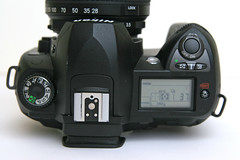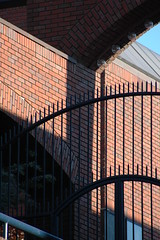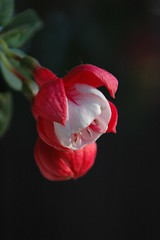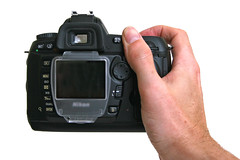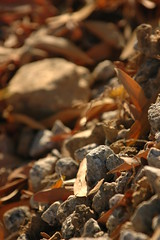Nikon D70s GuidePosted in August 2006 In this Nikon D70s guide, I'm also going to talk a lot about another Nikon camera. It's almost impossible to review the D70s without also talking about the Nikon D50. These two cameras share a lot in common, and if the few extra features offered by the D70s aren't really worth it to you, then the D50 is a more economical choice. While I will also talk about how the D70s compares to other cameras in its class, the differences between it and the D50 will be made abundantly clear. Let's start this Nikon D70s guide with a quick introduction to the basic camera features. |
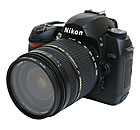 |
Quick Overview
- 6.0 megapixel sensor
- Compatible with Nikkor F-mount and D-type lenses
- 3 photos per second
- ISO settings from 200 to 1600
- Maximum shutter speed of 1/8000 of a second
- 1.5 times crop factor
- 2.0" LCD
- Stores photos on Compact Flash
- 5-area autofocus system
Key Feature
It's no surprise that the key feature of the D70s is also the key feature of the D50.
Both of these cameras have an incredibly fast flash synch speed.
The flash synch speed is the maximum shutter speed that your camera can use when the flash is activated.
For many digital SLR cameras, this maximum shutter speed is 1/250th of a second.
On the Nikon D50 and D70s, the flash synch speed is 1/500th of a second, twice as fast as virtually every other camera on the market.
This is a fantastic feature for portrait photographers who work in variable light conditions. Since you want your portrait subjects to look their best, there are many times where you're going to use the flash (even in broad daylight).
When you're trying to capture subjects that are moving around, you need to use fast shutter speeds, and sometimes 1/250 just isn't fast enough.
Who The Nikon D70s is For
The D70s is for portrait photographers who want manual control.
Here's some of the rationale for this:
- The fast flash synch speed (mentioned above) is ideal for outdoor portrait photography
- The D70s is easier to control manually than the D50
- The depth of field preview lets you check to make sure your entire portrait subject is in focus
- The D70s is not as suited for action photography as the D200 or Canon 30D (since it has a slower continuous frame rate)
- The fine color control on the D70s allows for natural skin tones under a wide variety of lighting conditions
If you're not sure why all of this terminology means, I'll explain it in just a moment.
If you don't want to read a lengthy explanation and are fairly sure that you'll never use the manual controls on a digital SLR, then I recommend that you take a look at the Nikon D50 Guide instead.
The D70s is not worth the extra money if you don't intend to leverage its manual controls.
In Comparison
In this section of the guide, I'll compare the Nikon D70s to other cameras in a similar price range.
If you're unclear about the different price ranges, read the article on digital SLR camera prices.
Compared to the D50
The D70s differs from the D50 in several key ways that make it more suitable for the advanced amateur portrait photographer.
First, the camera is easier to control manually, since it features two dials: one on the front and one on the back.
When you set the camera to manual exposure mode, one dial changes the aperture of the lens and the other changes the shutter speed of the camera.
On the D50 there is only one dial in the front, and it's not quite as easy to change both settings on the fly.
The second more critical difference is that the D50 doesn't have a depth of field preview. This feature sets the lens to the aperture that you have selected, so you can see a preview in the viewfinder before you take the shot.
Aperture affects depth of field: the space that is in focus in front of and behind the spot where the camera is focused.
This feature helps portrait photographers ensure that a subject's entire face is in focus - it's a real shame to get crystal-clear focus on the eyes, and then notice that the nose is just slightly out of focus (due to shallow depth of field).
Viewfinder Grid
One advantage that the D70s has over its competition (not just the D50) is the ability to display a grid in the viewfinder.
This may not seem like a huge advantage to you - I'll explain why I like it in a moment.
But first, some clarification. When you look through the viewfinder of most digital SLR cameras, the only thing that you see are the focus points.
These appear as small squares or rectangles within the field of view.
In addition to the focus points, the Nikon D70s also displays four grid lines, 2 horizontal and 2 vertical. Depending on the types of photos you take, these lines can be extremely helpful.
A common problem with most photographers is getting horizon lines level.
You look through the viewfinder, get everything lined up and take the picture. When you get home and look at the photo on your computer, that horizon line is clearly at an angle.
I found that the grid lines help to eliminate this problem - when you can line up the horizon with a line in the viewfinder, your chances of making it slanted are significantly reduced.
The second benefit is that the lines help you with your composition.
A common composition technique is called the rule of thirds, where you divide the frame into thirds and place important subjects off-center.
Since the grid lines in the Nikon D70s viewfinder are arranged in a rule-of-thirds pattern, this makes it easier for beginning photographers to learn this important photographic technique.
Fast...But Not THAT Fast
Is the D70s a fast camera? You bet.
As I was putting the camera through its paces for this D70s guide, I spent a lot of time trying to capture spontaneous moments.
I'm happy to report that the camera performed admirably.
But if you're going to be a die-hard action photographer, it may not be fast enough.
The D70s can take continuous photos a 3 photos per second, and can capture 12 consecutive shots before it starts to slow down.
Compare this to the higher-end Canon 30D or Nikon D200, and you can see the difference:
| Camera | Speed (photos per second) | # Consecutive Shots |
| Nikon D70s | 3 | 12 |
| Canon 30D | 5 | 23 |
| Nikon D200 | 5 | 37 |
Both the 30D and D200 also feature sophisticated autofocus systems that make it easy to track moving targets.
Can the D70s capture subjects in motion? Of course.
Just realize that the camera is better suited for more static subjects, which is why it's a better choice for portrait photographers.
No Black and White
Like the D50, the D70s does not have a black and white mode.
While you can convert any photo into black and white with software, you don't get the immediate feedback on the LCD screen about how your photo looks.
If you hold a deep love of traditional black and white photography, you might be better off with a camera like the Canon EOS Rebel XT.
How It Works
I mentioned in the first part of this Nikon D70s Guide that the camera is suited for people who want to use manual controls.
While the camera can be used fully automatic, many of its advanced features are designed to be adjusted manually.
Camera controls are also laid out intuitively for those who want complete control over aperture, shutter speed, ISO and white balance.
In Use
One problem that I had when using the D50 is that it was not easy for me to change camera settings manually.
The D50 only has one dial to change camera settings, and when you're using the camera in manual mode you have to change two: aperture and shutter speed.
On the D50, the dial changes the shutter speed, and you have to press and hold a button while spinning the dial to change aperture.
With the D70s there are two dials, one for each camera setting.
This may seem exceptionally picky, but the two dials really make a difference when you're in changing light conditions and you're trying to get the shot.
Once you're actively photographing, you have little time to think about your camera settings. Any extra effort ("where's that button I have to hold down?") distracts you and leads to a higher rate of missed photo opportunities.
But let me be clear: this is ONLY important if you want complete manual control.
If you don't see yourself taking the camera off of one of its auto-exposure modes, then having two dials to control the camera settings is irrelevant.
Size and Weight
One difference between the D70s and D50 that is not mentioned in my comparative feature analysis is size and weight.
The D70s has a much more "professional" camera feel to it - heavier and certainly more solid than the D50.
While this doesn't change the types of photos that the D70s takes relative to the D50, it does give you the impression that the camera is more durable and will withstand rougher treatment.
Color
Like the D50, the D70s cannot capture photos in black and white.
While any color photo can be changed to black and white using software, the true black and white enthusiast will want to consider a camera that has a black and white mode.
On the flip side, the color that the D70s captures is exceptional.
Without any adjustments at all, primary colors are saturated which makes for great landscape and nature photos.
The camera also offers an additional level of color control, allowing you to optimize the color capture depending on the type of photo you're taking (Portrait, Landscape, Vivid, etc.).
These adjustments - while nice - are subtle, and I had a hard time telling the difference in between some of them.
Batteries
I cannot say enough good things about the EN-EL3e.
This is the Energizer bunny of digital SLR batteries: it just keeps going and going and going.
Given the number of photos I take, I am used to recharging camera batteries about once a week. I am no stranger to the "low battery" warning.
With the Nikon D70s and the EN-EL3e, I couldn't seem to get the charge to drop below the halfway mark.
Even after several weeks of taking photos (and one vacation) including extensive use of the pop-up flash (which really eats battery power) the camera still showed a full charge.
I have had the battery charger ready and waiting for about a month now but haven't had to use it. Am I impressed? You bet.
Lenses
My recommendation for a camera of this caliber is to get a seperate lens besides what's offered in a package or "kit".
Here are several alternative lenses for the Nikon D70s:
| TYPE | MAKER | LENS | PRICE |
| Wide Angle Zoom | Sigma | 12-24mm f/4.5-5.6 | $ 600.00 |
| Wide Angle Zoom | Sigma | 15-30mm f/3.5-4.5 | $ 500.00 |
| Low Light | Nikon | 50mm f/1.8D | $ 110.00 |
| Low Light | Nikon | 50mm f/1.4D | $ 270.00 |
| Ultra Zoom | Nikon | 18-200mm f/3.5-5.6 ED AF-S VR DX | $ 800.00 |
| Ultra Zoom | Nikon | 80-400mm f/4.5-5.6D ED | $ 1,430.00 |
| Ultra Zoom | Tamron | 28-300mm f/3.5-6.3 XR Di LD | $ 365.00 |
| Telephoto Prime | Nikon | 400mm f/2.8D AF-S II | $ 7,700.00 |
| Telephoto Zoom | Nikon | 70-200mm f/2.8G ED-IF AF-S VR | $ 1,600.00 |
The Pros and Cons
| Pros | Cons |
|
|
Photo Samples
These Nikon D70s photos samples attempt to provide you with a wide range of subjects, lighting and color so that you can see how the camera performs under these different conditions. For more photos, see the complete Nikon D70s photo gallery.
 |
 |
 |
 |
 |
 |
 |
Price Analysis
After reading this Nikon D70s guide, it should be clear that this camera is very similar to the Nikon D50.
The few additional features that the camera includes are geared for photographers who want manual control.
If you don't want manual control then stick with the D50, because you will pay a premium for the extra features offered by the D70s.
You might have a tough time finding a D70s to purchase.
Given the popularity of the D50 and the introduction of the new D80, new D70s cameras are becoming hard to find.
| MAKER | CAMERA | U.S. PRICE | UK PRICE |
| Pentax | K100D with 18-55mm lens | $ 594.00 | n/a |
| Nikon | D50 with 18-55mm lens | $ 650.00 | £ 378.00 |
| Canon | EOS 350D with 18-55mm lens | $ 735.00 | £ 443.00 |
| Nikon | D70s with 18-55mm lens | $ 875.00 | £ 561.00 |
Accessories
The most important accessory you're going to need for your Nikon D70s is a good memory card.
The D70s uses Compact Flash cards, which you can get in capacities up to 8GB. This is a bit much, and I typically recommend that you get two or more cards with a smaller capacity, so that if one dies you don't lose thousands of photos.
| CARD | SIZE | PRICE |
| SanDisk Ultra II | 512 MB | $ 35.00 |
| SanDisk Ultra II | 1 GB (1024 MB) | $ 51.00 |
| SanDisk Ultra II | 2 GB | $ 100.00 |
For Owners
This section of the Nikon D70s guide is for existing owners of this digital SLR.
Whether you'd like to know more about how to use your camera, or are just looking for a lost manual, the following links will help guide you on your way.
Manuals
Can't remember how to use a special camera feature? Can't find your D70s user manual? That's OK!
Digital SLR Lessons
Tired of missing great photo opportunities even though you have an advanced digital SLR camera?
I'll let you in on a little secret: there's nothing wrong with your camera.
Digital SLRs are great at taking photos, but not so good at making decisions - it's up to you to know what you want and to take manual control when you have to.
Here's some good news: it's easier to learn how to use your digital SLR than you might think.
In fact, you can learn all about all the features of your Nikon D50 digital SLR camera in just 5 easy online lessons.
Reference Books
| United States | United Kingdom | |
| Digital SLR Home | Other Camera Guides |
